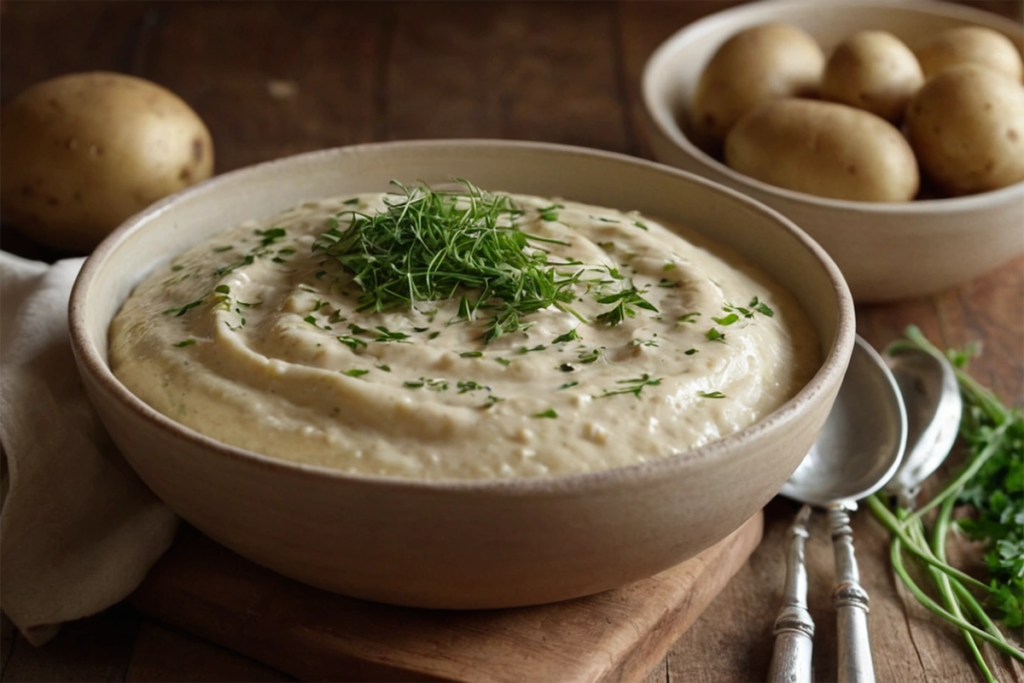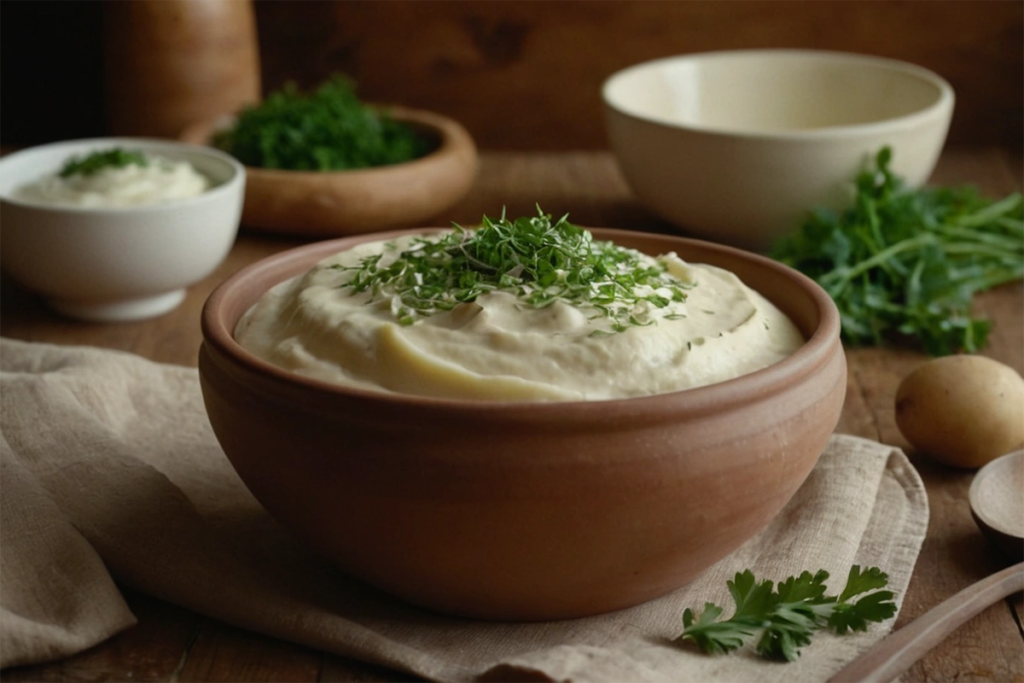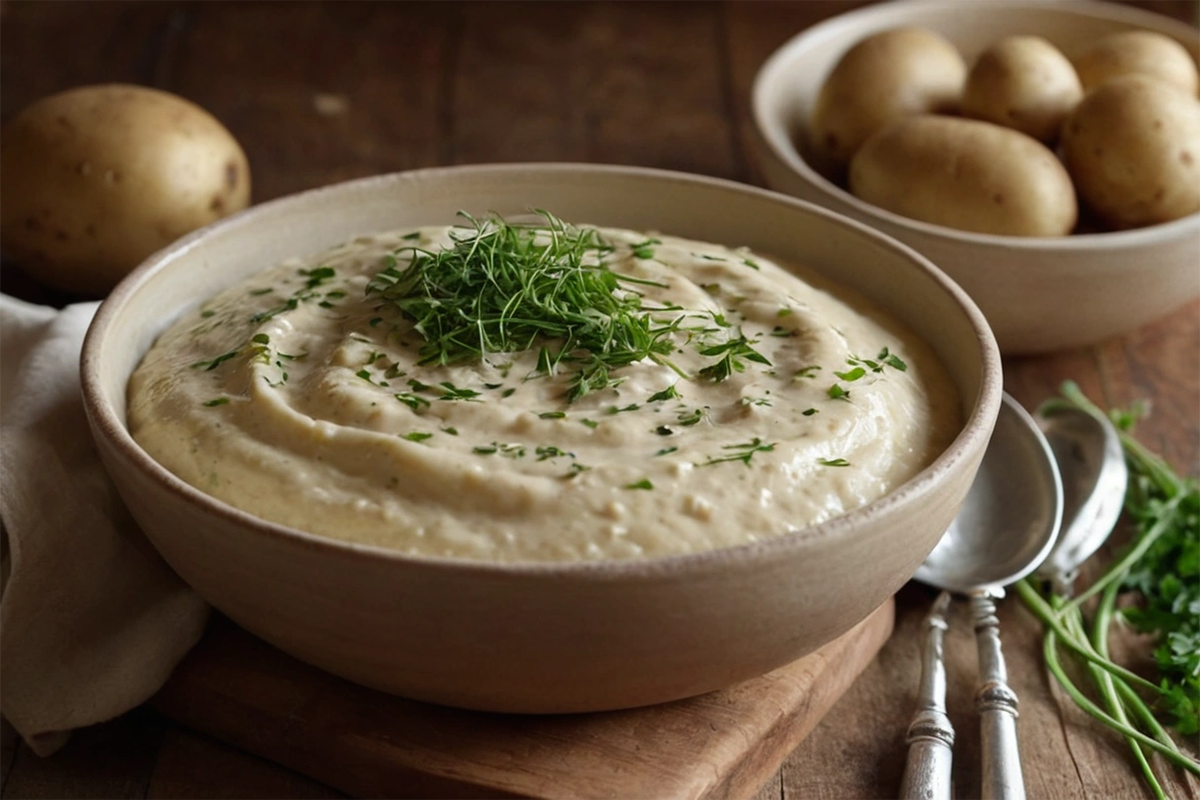Potato mud, also known as creamy mashed potatoes, is a comfort food classic that never fails to satisfy. With its smooth, rich texture and buttery flavor, it’s a dish that pairs well with a variety of meals or stands alone as a hearty side. Whether you’re making it for a holiday feast or a cozy weeknight dinner, mastering the art of making potato mud is essential for any home cook.
In this article, we’ll delve into the steps to create the perfect potato mud, starting with selecting the right potatoes and moving on to serving it with creative pairings. Moreover, along the way, we’ll explore tips and tricks to enhance the dish, ensuring your potato mud is always a hit.
Table of Contents
Introduction to Potato Mud
What is Potato Mud?
Potato mud is simply a playful term for mashed potatoes, a staple dish made by boiling potatoes and mashing them into a smooth, creamy consistency. This dish is beloved for its versatility, allowing for endless variations with different add-ins and seasonings. Whether you prefer it plain with butter and cream or loaded with cheese and herbs, potato mud is a dish that can be tailored to suit any taste.
Why It’s a Popular Dish
One of the reasons potato mud is so popular is its comforting nature. The creamy texture and rich flavor make it a perfect accompaniment to a wide range of main dishes, from roast meats to grilled vegetables. Moreover, it’s a dish that’s easy to prepare, making it accessible to cooks of all skill levels. The simplicity of the ingredients, combined with the potential for endless customization, has solidified potato mud as a favorite in households around the world.

Ingredients and Preparation
Core Ingredients
Choosing the Right Potatoes
The foundation of great potato mud starts with selecting the right type of potatoes. For the creamiest, smoothest texture, Russet and Yukon Gold potatoes are the top choices. Russets are starchy and break down easily when cooked, making them ideal for mashing. Yukon Golds, on the other hand, have a slightly buttery flavor and a creamy texture, which adds richness to the dish. For the best results, you might even consider using a combination of both.
To learn more about choosing the right potatoes for your dishes, check out this guide on types of potatoes.
Essential Add-Ins: Butter, Cream, and Cheese
The classic ingredients that turn mashed potatoes into creamy potato mud are butter and cream. Butter adds richness and a smooth mouthfeel, while cream gives the dish its luxurious texture. For a more decadent version, you can add grated cheese like cheddar, Parmesan, or even cream cheese for extra tanginess.
Start with room temperature butter and warm cream to ensure they incorporate smoothly into the mashed potatoes. This prevents the potatoes from becoming lumpy and helps achieve that perfect, velvety consistency.
Optional Ingredients: Garlic, Herbs, and Bacon
For those looking to add extra flavor to their potato mud, there are several optional ingredients you can include. Garlic is a popular addition that infuses the dish with a robust, savory note. You can sauté the garlic in butter before adding it to the potatoes, or roast it for a sweeter, mellower flavor.
Herbs like chives, parsley, and thyme can add freshness and color, elevating the dish’s presentation and taste. While many enjoy adding bacon to their potato dishes, this recipe will skip it to keep the dish versatile and suitable for a wider range of dietary preferences.
Seasonings: Salt, Pepper, and Beyond
No potato dish is complete without proper seasoning. At a minimum, you’ll want to season your potato mud with salt and pepper to taste. To take the flavors to the next level, consider adding a pinch of nutmeg for warmth or a dash of paprika for a subtle smoky flavor.
Seasoning is highly personal, so feel free to experiment with different spices and herbs to find the combination that best suits your palate.

Cooking Process
Preparing the Potatoes
The first step in making perfect potato mud is preparing the potatoes. Start by peeling the potatoes and cutting them into evenly sized chunks. This ensures that they cook at the same rate, preventing some pieces from becoming overcooked while others remain underdone.
Place the potato chunks in a large pot and cover them with cold water. Add a generous pinch of salt to the water, which will help season the potatoes as they cook. Bring the water to a boil over medium-high heat, then reduce the heat to a simmer. Cook the potatoes for about 15-20 minutes, or until they are fork-tender.
Once the potatoes are cooked, drain them well in a colander and return them to the pot. Allow the potatoes to steam for a minute or two, which helps remove excess moisture and prevents the final dish from becoming watery.
Mashing Techniques
Mashing the potatoes is where the magic happens, turning boiled potatoes into smooth and creamy potato mud. There are several methods you can use, depending on the texture you prefer:
- Potato Masher: This classic tool is perfect for a more rustic texture, leaving a few lumps in the potatoes.
- Ricer or Food Mill: For the smoothest possible texture, a ricer or food mill will give you light, fluffy mashed potatoes with no lumps.
- Hand Mixer: For a quick and easy option, a hand mixer can be used to whip the potatoes into a smooth, airy consistency. Just be careful not to overmix, as this can make the potatoes gummy.
Incorporating the Cream and Butter
With the potatoes mashed, it’s time to incorporate the butter and cream. Start by adding the butter in small chunks, stirring or mashing it into the potatoes until fully melted. Next, slowly pour in the warm cream, stirring constantly until the potatoes reach your desired consistency.
The amount of cream you use will depend on how rich and creamy you want the final dish to be. To begin, start with a small amount and add more as needed, tasting as you go. Additionally, if you’re adding cheese, now is the time to stir it in, allowing it to melt into the potatoes for a rich, savory flavor.
Adding the Cheese and Optional Ingredients
For those who want to take their potato mud to the next level, adding cheese is a must. Sharp cheddar adds a tangy richness, while Parmesan brings a salty, nutty flavor. Stir the cheese into the hot potatoes until it’s fully melted and incorporated.
If you’re using other optional ingredients like garlic or herbs, then now is the time to add them as well. Next, gently fold them into the potatoes, ensuring they are evenly distributed. Finally, taste the potatoes and adjust the seasoning with more salt and pepper if needed.

Serving Suggestions
How to Serve Potato Mud
Potato mud is an incredibly versatile dish that can be served in many ways. To illustrate, here are some traditional and creative serving suggestions to help you make the most of this comforting side dish.:
Traditional Ways to Serve
- With Roast Meats: Potato mud is a classic pairing with roast meats like chicken, beef, or lamb. The creamy texture complements the rich flavors of the meat, and the potatoes are perfect for soaking up any juices or gravy.
- Topped with Gravy: For a truly indulgent meal, serve your potato mud topped with a rich gravy. Whether you prefer a classic brown gravy or a lighter herb sauce, the combination is sure to please.
- Alongside Vegetables: Pair potato mud with steamed or roasted vegetables for a well-rounded meal. The creamy potatoes provide a satisfying contrast to the crisp, fresh veggies.
Creative Serving Ideas
- In a Casserole: Turn your potato mud into a comforting casserole by layering it with vegetables and cheese, then baking until golden and bubbly. This is a great way to use up leftovers or create a make-ahead meal for busy weeknights.
- As a Topping for Shepherd’s Pie: Use potato mud as the topping for a hearty shepherd’s pie. The creamy potatoes form a delicious crust that complements the savory meat and vegetable filling.
- With a Variety of Toppings: Set up a potato mud bar with a variety of toppings like sour cream, chives, shredded cheese, and even sautéed mushrooms. This allows everyone to customize their serving to their taste.
FAQs (Frequently Asked Questions)
Can Potato Mud Be Made Ahead of Time?
Yes, potato mud can be made ahead of time, which makes it a convenient option for busy days or holiday meals. To prepare it in advance, follow the recipe as usual, then transfer the mashed potatoes to a baking dish. Cover the dish tightly with foil and refrigerate for up to two days. When you’re ready to serve, reheat the potatoes in a 350°F oven for 20-30 minutes, or until heated through. Stir occasionally to ensure even heating.
What’s the Best Way to Reheat Potato Mud?
The best way to reheat potato mud is either in the oven or on the stovetop. For instance, for oven reheating, transfer the potatoes to a baking dish and cover them with foil Bake at 350°F for 20-30 minutes, stirring occasionally. On the stovetop, place the potatoes in a saucepan and heat over low heat, stirring frequently. If the potatoes seem dry, add a splash of cream or milk to restore their creamy texture.
Can I Make a Healthier Version?
To make a healthier version of potato mud, you can substitute some of the butter and cream with lighter alternatives. Use low-fat milk or a dairy-free milk like almond or oat milk, and replace some of the butter with olive oil for a heart-healthy fat. You can also increase the proportion of vegetables by mixing in pureed cauliflower or parsnips, which adds nutrition and reduces the overall calorie content.
Is There a Dairy-Free Option for Potato Mud?
Yes, potato mud can be made dairy-free by using plant-based alternatives. Replace the butter with a vegan butter or margarine, and use a creamy plant-based milk like almond, soy, or oat milk in place of cream. You can also add a tablespoon of nutritional yeast for a cheesy flavor without the dairy.
What Can I Do if My Potato Mud is Too Runny?
If your potato mud turns out too runny, there are a few ways to fix it. First, try simmering the potatoes on the stovetop over low heat, stirring constantly. This approach can help evaporate some of the excess moisture. However, if that doesn’t work, you can also add more mashed potatoes or even a spoonful of instant potato flakes to thicken the mixture. Finally, be sure to adjust the seasoning if you add more potatoes.
How Can I Add More Flavor to Potato Mud?
To add more flavor to your potato mud, consider experimenting with different herbs and spices. Fresh herbs like chives, parsley, or thyme can add brightness and freshness, while roasted garlic or caramelized onions bring a deep, savory note. For a spicy kick, try adding a pinch of cayenne pepper or smoked paprika. You can also mix in other cheeses like Gouda or blue cheese for a unique twist.
Conclusion and Final Thoughts
Summary of Potato Mud Recipe
Potato mud is a simple yet satisfying dish that has rightfully earned its place as a comfort food favorite. By carefully choosing the right potatoes and incorporating butter, cream, and other flavorful ingredients, you can create a dish that’s rich, creamy, and perfect for any occasion. Whether you’re serving it alongside a holiday roast or as a cozy weeknight side, potato mud is a dish that’s sure to please.
Encouragement to Try Different Variations
One of the best things about potato mud is its versatility. Don’t be afraid to experiment with different ingredients and flavors to make the dish your own. Whether you prefer it classic and creamy or loaded with cheese and herbs, there’s a version of potato mud out there for everyone. So, grab some potatoes and get mashing—you’re sure to create a dish that will become a staple in your recipe collection.

